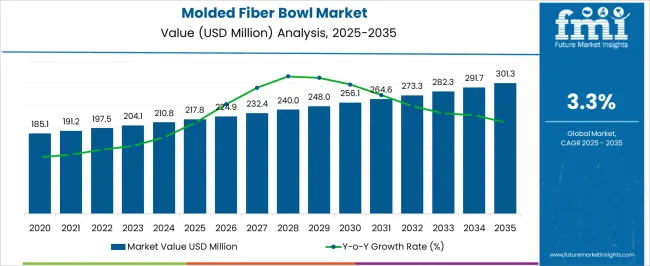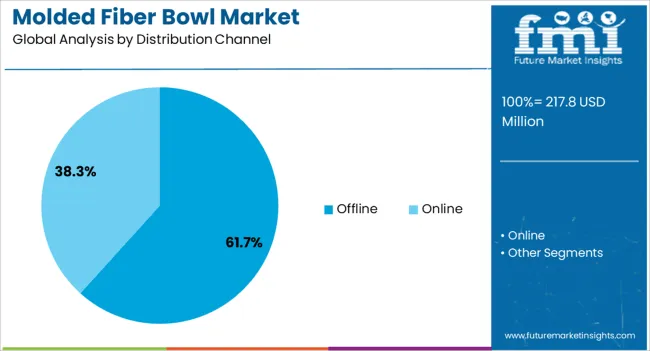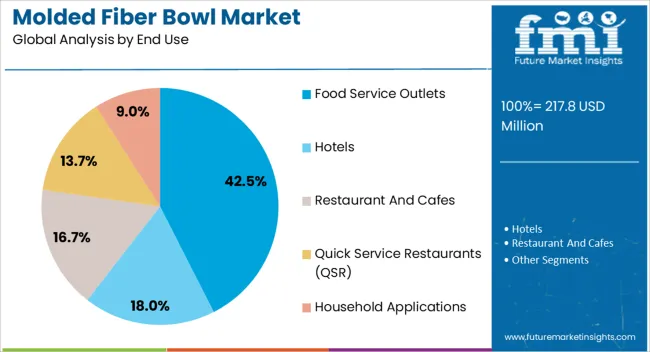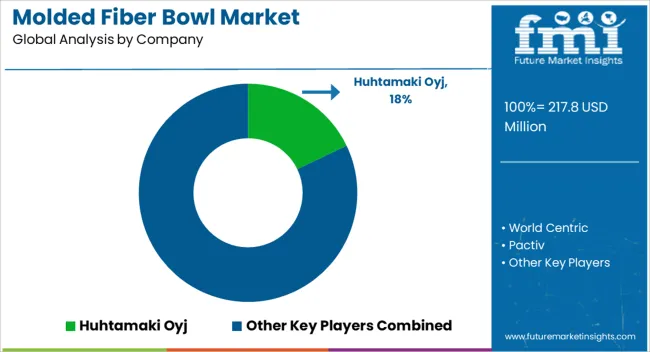The Molded Fiber Bowl Market is estimated to be valued at USD 217.8 million in 2025 and is projected to reach USD 301.3 million by 2035, registering a compound annual growth rate (CAGR) of 3.3% over the forecast period.
The molded fiber bowl market is expanding steadily, supported by growing consumer demand for sustainable packaging alternatives and global regulatory pressures to reduce single-use plastic consumption. Industry news and packaging manufacturer announcements have emphasized a transition toward biodegradable and compostable food containers, with molded fiber bowls gaining traction across foodservice and retail sectors.
The rising popularity of takeout and on-the-go meals, coupled with heightened environmental awareness, has accelerated the adoption of molded fiber solutions that align with circular economy goals. Technological advancements in fiber molding processes have improved product quality, barrier properties, and design flexibility, enabling wider applicability.
Food safety regulations and labeling standards have also played a role in shaping the market, prompting innovations in moisture- and oil-resistant coatings for molded fiber bowls. Looking forward, growth is anticipated from emerging economies embracing eco-friendly packaging and from broader distribution across both digital and traditional retail networks. Key segmental momentum is being led by Transfer Molded pulp types, Offline retail channels, and Food Service Outlets, which together reflect a balance of scalability, accessibility, and demand concentration in eco-conscious food consumption spaces.

| Metric | Value |
|---|---|
| Molded Fiber Bowl Market Estimated Value in (2025 E) | USD 217.8 million |
| Molded Fiber Bowl Market Forecast Value in (2035 F) | USD 301.3 million |
| Forecast CAGR (2025 to 2035) | 3.3% |
The market is segmented by Molded Pulp Type, Distribution Channel, and End Use and region. By Molded Pulp Type, the market is divided into Transfer Molded, Thick Wall, Thermoformed Fiber, and Processed Pulp. In terms of Distribution Channel, the market is classified into Offline and Online. Based on End Use, the market is segmented into Food Service Outlets, Hotels, Restaurant And Cafes, Quick Service Restaurants (QSR), and Household Applications. Regionally, the market is classified into North America, Latin America, Western Europe, Eastern Europe, Balkan & Baltic Countries, Russia & Belarus, Central Asia, East Asia, South Asia & Pacific, and the Middle East & Africa.

The Transfer Molded segment is projected to contribute 36.4% of the molded fiber bowl market revenue in 2025, maintaining its lead among pulp molding techniques. This segment’s growth has been supported by its ability to produce thinner-walled, high-precision fiber products with enhanced surface finish and structural integrity.
Transfer molding has been favored by manufacturers seeking scalability and dimensional accuracy, especially for branded food packaging that demands consistent shape and appearance. Press releases from packaging companies have highlighted process improvements that have reduced drying times and increased production efficiency in this segment.
Additionally, transfer molded fiber bowls are compatible with automation lines and can incorporate custom textures or branding, meeting the marketing and functional needs of food retailers. As sustainability benchmarks continue to evolve, the Transfer Molded segment is expected to retain its advantage through its capacity to deliver both aesthetics and eco-performance at commercial volumes.

The Offline segment is expected to account for 61.7% of the molded fiber bowl market revenue in 2025, affirming its status as the dominant distribution channel. This segment’s strength has been driven by the presence of well-established supply chains and procurement practices across food service distributors, wholesalers, and retail outlets.
Offline channels have continued to serve institutional buyers such as restaurants, hotels, and catering businesses that require consistent bulk orders and negotiated pricing. Packaging expos, trade shows, and supplier contracts have remained effective touchpoints for molded fiber bowl transactions, especially in B2B environments.
Furthermore, in regions where digital infrastructure is still maturing, offline networks have ensured consistent product availability and logistical support. As sustainability mandates influence purchasing decisions across commercial foodservice chains, offline distributors have increasingly stocked certified eco-friendly fiber packaging, reinforcing their role in market expansion. The Offline segment is expected to maintain its lead due to strong institutional demand and entrenched supply relationships.

The Food Service Outlets segment is projected to capture 42.5% of the molded fiber bowl market revenue in 2025, positioning it as the leading end-use segment. Growth in this segment has been catalyzed by the rapid expansion of quick-service restaurants, cafes, and delivery-focused food businesses emphasizing sustainable packaging.
Environmental regulations targeting single-use plastics have led to a surge in demand for molded fiber alternatives that meet compostability and recyclability standards. Food service brands have prioritized fiber bowls for their functionality in hot and cold food applications, leak resistance, and brand-friendly design options.
Reports from industry stakeholders have also pointed to rising customer preference for eco-labeled and visually appealing packaging, which has enhanced product differentiation. As delivery platforms and takeout services grow globally, particularly in urban centers, molded fiber bowls have become essential to maintaining food presentation while supporting green initiatives. The Food Service Outlets segment is expected to remain a major driver of volume and innovation within the molded fiber packaging landscape.
Budding Need for Sustainability to be a Key Trend
Sustainability is a key factor in procurement decisions, with consumer preference for eco-friendly packaging materials. Global regulations promote a circular economy, leading to retailers and manufacturers using post-consumer recycled or renewable content.
The demand for molded fiber is widespread as a compostable alternative to plastic packaging. The compound is a sustainable solution for various industries, as the material breaks down quickly in the natural environment, thereby reducing plastic pollution in oceans and landfills.
The FMCG brands can differentiate the products using molded fiber packaging by communicating strong, sustainable credentials to environmentally conscious customers. The heightened policy push and consumer demand for sustainable options are convincing many companies to adopt molded fiber for food and beverage packaging.
Multiple Sectors Cultivate the Demand for Agro-friendly Packaging Material
The molded fiber bowl market is undergoing a transition due to the increasing demand for environmentally friendly packaging made from renewable and recyclable materials. Non-wood products like wheat and bagasse are also being used for pulp production.
Agro-friendly packaging, made from natural fibers like bamboo, wheat, or sugarcane, is gaining popularity for its environmental benefits. The material also boasts high recycling capabilities, which allow it to be reused up to seven to ten times.
Molded grain pulp is a biodegradable alternative to traditional plastic packaging, reducing the need for raw materials in packaging items. The food and beverage sector is promoting the demand for agro-friendly packaging for the sake of the environment.
For instance, PulPac, creator of Dry Molded Fiber technology, joined the global initiative Two Sides in April 2025, advocating for sustainability in print, paper, and paper packaging.
Improvements in the Fiber Molding Technologies Favored By Manufacturers
Impulse drying is a cost-effective and efficient method for manufacturing molded fiber food bowls using 3D-printed mold tooling. Such a process simplifies production, allows easy branding, and uses creative designs to boost product sales, making it a popular choice in the packaging industry.
Molded fiber bowls are particularly in demand in the food sector. The cushioning properties of these bowls provide excellent protection for food products, preventing damage from impacts on the packaging material. Such a feature has earned the trust of end-users, who value the security supplied by molded fiber food packaging.
Molded fiber bowls and trays are gaining popularity as manufacturers balance cost-effectiveness with high-quality packaging. As the industry evolves, innovations are anticipated to enhance the efficiency and effectiveness of this packaging format.
The global market recorded a CAGR of 2.6% between 2020 and 2025. Market growth of molded fiber bowls was positive and reached a value of USD 217.8 million in 2025 from USD 185.1 million in 2020.
The molded fiber bowl market is experiencing a ripple due to improved shopper preference for ready-to-consume food, take-out menus, and home delivery services. The convenience and eco-friendliness of food bowls have contributed to the demand in the food service industry.
Developed economies like the United States and the United Kingdom are anticipated to propel market growth in quick-service restaurants. This is due to the lightweight, durable, and cost-effective packaging they offer.
Developing economies such as India and China are increasingly adopting molded fiber bowls due to the popularity of QRS bowls.
Several research studies indicate that the presence of perfluoroalkyl (PFA) in the fiber molding process is anticipated to pose health risks. This could potentially hinder the global growth of molded fiber bowls and prompt manufacturers to research safer, more sustainable alternatives.
Manufacturers and food service providers are increasingly adopting molded fiber bowls as an alternative to single-use plastic and Styrofoam. The sustainable bowls are recyclable, compostable, and biodegradable, making them an eco-friendly packaging option. Such a trend is anticipated to continue as the demand for environmentally friendly packaging alternatives grows in the future.
The section below covers the forecast for the molded fiber bowl market in terms of countries. Information on key countries in several parts of the globe, where the demand for sustainable bowls from Asia Pacific countries such as China and India is widespread.
The demand from the United States is displaying a ripple in the market. European countries such as Germany and the United Kingdom are exhibiting the transition in sales of molded fiber bowls in the food service industry.
| Countries | CAGR 2025 to 2035 |
|---|---|
| United States | 2.4% |
| Germany | 2.1% |
| United Kingdom | 2.6% |
| China | 5.7% |
| India | 6.6% |
The sales of molded fiber bowls in the United States are projected to undergo a transition during the forecast period. The growth is foreseen to be manipulated by an assortment of elements. These include the high adoption of advanced technology and the presence of leading packaging manufacturers in the United States.
The United States molded fiber bowl market is estimated to account for a CAGR of 2.4% from 2025 to 2035. This indicates a steady and sustained growth trajectory throughout the forecast period.
The development offers a lucrative prospect for manufacturers and businesses operating in the packaging industry. It allows them to tap into the emerging demand for eco-friendly and sustainable packaging solutions.
The quick service restaurants and the emerging demand for food delivery platforms are driving the demand for molded fiber food packaging in China.
As the Western culture of fast food mainly influences the region, the culinary innovators in China are also recreating several authentic Chinese cuisines. These dishes mostly consist of soups, noodles, and rice, which can be served in eco-friendly bowls.
The hotel industry, and restaurants and cafes in China are augmenting the sales of sustainable molded fiber bowls. Based on the rising application in the HoReCa sector, the molded fiber bowl market in China is anticipated to register a CAGR of 5.7% from 2025 to 2035.
The demand for molded fiber bowls in India is anticipated to rise due to their eco-friendliness and cost-effectiveness. This makes them a popular choice among environmentally conscious consumers.
India’s molded fiber bowl market is projected to showcase a CAGR of 6.6% in the forecast period. Owing to the Premiumization trend in the country is projected to play a significant role in pushing demand for molded fiber food packaging bowls.
The growing popularity of home delivery and takeout services, especially in the food industry of India, is desired to provide further impetus to the market. Manufacturers in the country are moving toward sustainable packaging solutions to attract youngsters and retain the flavor of edible products.
The section contains information about the leading segments in the industry. Manufacturers are mainly utilizing transfer molded bowls based on molded pulp type, which accounts for 51.7% of revenue in 2025. At the same time, food service outlets are growing their popularity, acquiring 32.4% of the revenue share.
| Segment | Transfer Molded (Molded Pulp Type) |
|---|---|
| Value Share (2025) | 51.7% |
Manufacturers in the food packaging industry are increasingly focusing on the development of transfer molded bowls made from molded pulp. The transparent food packaging trend is attributed to the significant benefits offered by transfer molded pulp, particularly in terms of packaging transparency.
In 2025, transfer-molded bowls are predicted to overwhelm the food packaging industry with a 51.7% market share. This growth is propelled by increasing consumer demand for eco-friendly packaging and the superior quality and durability of transfer-molded pulp.
The transfer molded segment is predicted to experience significant growth due to its lightweight, durable, water-resistant, cost-effective, and reusable properties. Such packaging solutions are created by heating closed-cell foams and molding them into desired shapes using force and suction-forming techniques.
The transfer molded pulp is preferred by businesses for its cost-effectiveness and reusability, making them sustainable packaging options. The popularity of transfer molded bowls is expected to continue due to their versatility and dependability.
These are particularly favored in the food and beverage industry, where demand for eco-friendly and sustainable packaging solutions is growing.
| Segment | Food Service Outlets (End Use) |
|---|---|
| Value Share (2025) | 32.4% |
Food service outlets account for a significant share of 32.4% of the global molded fiber bowl market in 2025. The fast food service trend can be attributed to the growing popularity of molded fiber bowls as a cost-effective, biodegradable, and convenient packaging solution in the food service sector.
Molded fiber bowls are gaining popularity due to their affordability, cleanliness, and eco-friendliness. These bowls are made from 100% renewable materials and are compostable, making them suitable for environmentally conscious consumers.
The molded fiber food bowls are also stackable and convenient for on-the-go use, making them ideal for cafeterias, fast-food restaurants, and food trucks. The segment is anticipated to experience steady growth and strong sales due to the numerous benefits.
Consumers are seeking sustainable and convenient alternatives to traditional food packaging, and molded fiber bowls are well positioned to meet the demand from food service outlets.

The molded fiber bowl market is currently an active hub of innovation, offering fertile ground for novel ideas in a dynamic ecosystem. Manufacturers of molded fiber trays and bowls are focusing on the development of new products and expanding their geographical presence.
To achieve such goals, the firms are partnering with local brands and start-up companies to create sustainable packaging solutions, such as ecological bowls.
Such a marketing strategy enables companies to broaden their reach and gain more customers. Additionally, the companies are launching recycling programs in urban and remote areas to meet the ever-increasing demand for environmentally friendly packaging.
The stringent ecological measures are a response to the growing environmental concerns of consumers, which have become a major aspect of the market.
Industry Updates
The industry is segmented into thick wall, transfer molded, thermoformed fiber, and processed pulp, based on the molded pulp types.
Based on the distribution channels, the sector is bifurcated into online and offline distribution channels.
End use category include food service outlets, hotels, restaurant and cafes, quick service restaurants (QSR), and household applications.
Key countries of North America, Latin America, East Asia, South Asia and Pacific, Western Europe, Eastern Europe, and the Middle East and Africa are covered.
The global molded fiber bowl market is estimated to be valued at USD 217.8 million in 2025.
The market size for the molded fiber bowl market is projected to reach USD 301.3 million by 2035.
The molded fiber bowl market is expected to grow at a 3.3% CAGR between 2025 and 2035.
The key product types in molded fiber bowl market are transfer molded, thick wall, thermoformed fiber and processed pulp.
In terms of distribution channel, offline segment to command 61.7% share in the molded fiber bowl market in 2025.






Full Research Suite comprises of:
Market outlook & trends analysis
Interviews & case studies
Strategic recommendations
Vendor profiles & capabilities analysis
5-year forecasts
8 regions and 60+ country-level data splits
Market segment data splits
12 months of continuous data updates
DELIVERED AS:
PDF EXCEL ONLINE
Molded Wood Pallets Market Forecast and Outlook 2025 to 2035
Molded FRP Grating Market Size and Share Forecast Outlook 2025 to 2035
Molded Foam Market Size and Share Forecast Outlook 2025 to 2035
Molded Pulp Packaging Market Size and Share Forecast Outlook 2025 to 2035
Molded Pulp Basket Market Size and Share Forecast Outlook 2025 to 2035
Molded Underfill Material Market Size and Share Forecast Outlook 2025 to 2035
Molded Pulp Packaging Machines Market Analysis - Growth & Forecast 2025 to 2035
Market Share Breakdown of the Molded Pulp Basket Industry
Competitive Overview of Molded Wood Pallets Market Share
Molded Case Circuit Breaker (MCCB) Market Growth – Trends & Forecast 2023-2033
Molded Interconnect Devices (MID) Market
Molded Fiber Egg Packaging Market Forecast and Outlook 2025 to 2035
Molded Fiber Pulp Packaging Industry Analysis in Australia and New Zealand Forecast Outlook 2025 to 2035
Molded Fiber Pulp Packaging Market Size and Share Forecast Outlook 2025 to 2035
Molded Fiber Packaging Market Size and Share Forecast Outlook 2025 to 2035
Molded Fiber Pulp Cap Market Size and Share Forecast Outlook 2025 to 2035
Molded Fiber Pulp Packaging Market Size and Share Forecast Outlook 2025 to 2035
Molded Fiber Cup Market Size and Share Forecast Outlook 2025 to 2035
Molded Fiber Wine Packs Market Size and Share Forecast Outlook 2025 to 2035
Molded Fiber Pulp Edge Protectors Market Size and Share Forecast Outlook 2025 to 2035

Thank you!
You will receive an email from our Business Development Manager. Please be sure to check your SPAM/JUNK folder too.
Chat With
MaRIA